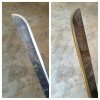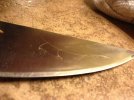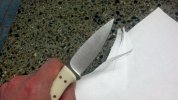- Joined
- Mar 8, 2008
- Messages
- 26,124
Here’s a blade that shows a V edge and three different convex edges. The V edge is defined by three points: the apex and the two points of the edge shoulder.
The red line represents a convex edge using the same three points, with a tight arc. This convex edge is fat, stout and obtuse. It will be very strong, but not a good cutter, compared to the V edge.
The pencil line represents a convex edge using the same three points, but with a gentle arc. It’s still not as aggressive a cutter as the V edge, but it’s better than the red convex edge.
The green arc represents a convex edge where the shoulder was raised. This edge is almost as acute as the V edge, but also can cut deeper before the width of the blade begins to limit cutting ability.
Three convex edges, all very different. We always talk about convex edges as if they are all the same. They are not.
So, Fastriot got a convex edge profiled by someone else to standards he knew nothing about. Then he tried to resharpen it, but his own standard was most likely quite different than that used by the previous sharpener. If the original convex was like the red angle and he tried to resharpen it using the green angle, he would have to sharpen a very, very long time before he’d even approach the apex.
Convex angles can be awesome, but they can also be terrible cutters. Or anything in between. And because we talk about them without defining them, we usually end up talking past each other.

Just remember that in the diagram obviously all the shown edges have radically different effective edge angles. Using that same variable V or linear edges are just as capable of being excellent, or awful.





